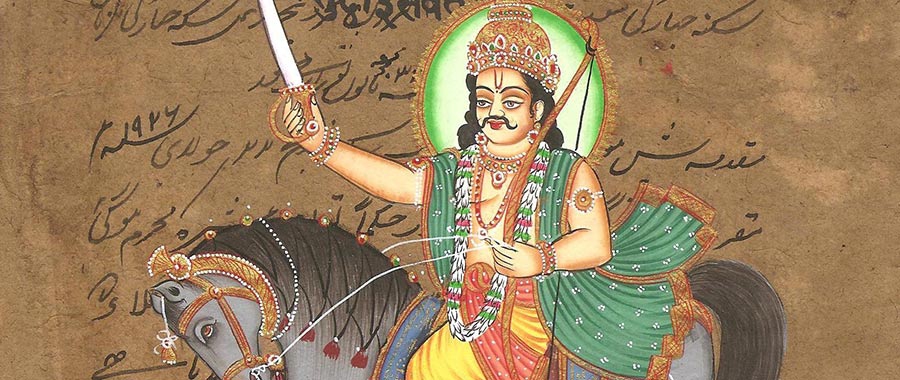The views expressed in our content reflect individual perspectives and do not represent the authoritative views of the Baha'i Faith.
Is Baha’u’llah the spiritual advent of the Kalki Avatar, the Hindu messiah?
The answer to that question ultimately becomes a matter of faith. Yet faith can be based on reason, and evidence—so this question invites some investigation.
The Baha’i principle of the harmony of science and religion—which is a universal principle made sacred in the Baha’i teachings—may be brought to bear on this question, through the use of history, a kind of scientific inquiry in its own right.
So these questions naturally arise: How and when did Baha’u’llah come to be identified with the Kalki avatar? Who was Kalki? How did his tradition originate? More importantly, do the descriptions of Kalki favorably compare with Baha’u’llah’s life and mission? The short answer is no—not unless the Kalki traditions are radically reinterpreted.
This is all the more important because the identification of Baha’u’llah with Kalki requires some careful nuancing. It is not a claim that should be taken at face value, upon further investigation.
First, how did Baha’u’llah come to be associated with the messianic figure of Kalki? In 1915, George O. Latimer’s “The Call Of God” was published as the featured article in a prominent American Baha’i publication: Star Of The West, Vol. 6, No. 15 (December 12, 1915), pp. 114–120. The footnote on p. 114 reads: “*Note – Compiled in Stuttgart, Germany, during August, 1914. This manuscript was presented to Abdul-Baha personally by Mr. Latimer while in Akka in October of the same year. Abdul-Baha gave consent to its publication. — The Editors.”
This is quite an endorsement, because it appears that Abdul-Baha approved the article for publication, presumably having reviewed its contents. As Abdul-Baha did not read English, one can only speculate if a translator read Latimer’s article to Abdul-Baha in Persian translation.
In this article, Latimer states that “the Hindoos await the appearance of the tenth incarnation of truth, called Kalki” (p. 117) and, further:
These three divine men (the Bab, Baha’u’llah and Abdul-Baha) have not only fulfilled the spiritual prophecies of all the former religions, but they have manifested by their words and deeds of the true qualities and requisites necessary to the divine and perfect educator. – p. 119.
Here, Baha’u’llah is proclaimed as “the promised one of all religions” (p. 118), a common Baha’i declaration of faith:
… the Promised One of all the world’s peoples hath now been made manifest. For each and every people, and every religion, await a Promised One, and Baha’u’llah is that One Who is awaited by all; and therefore the Cause of Baha’u’llah will bring about the oneness of mankind, and the tabernacle of unity will be upraised on the heights of the world, and the banners of the universality of all humankind will be unfurled on the peaks of the earth. – Abdu’l-Baha, Selections from the Writings of Abdu’l-Baha, p. 101.
These statements, when read together, lead to the conclusion that the author, George Latimer (claiming Abdu’l-Baha’s approval), explicitly associated messianic traditions of the Kalki avatar with Baha’u’llah’s advent.
Did this messianic association of Baha’u’llah and Kalki gain traction among Hindu Baha’is? In India, songs, called “bhajans,” were composed by Baha’is for teaching purposes. One of the “Baha’i bhajans” joyously proclaims:
The Kalki Avatar
Arise! O children of India, the Kalki avatar has come.
Vishnu’s avatar has come with the name Baha’u’llah.
Nowhere in the entire world can the influence of religion be seen.
The wicked have obtained everything; the truthful have lost all;
According to the Gita, the time of Vishnu’s avatar has come.
The Gita has said when circumstances are such,
religion is again established just as it has happened today.
In order to save the righteous, the Kalki avatar has come.
Foolish people have not realized that Vishnu’s avatar has come again.
Radha and Arjuna knew that the Lord had taken a new abode.
The eternal has once again manifested himself, the avatar of God.
– quoted by Daniel E. Bassuk, Incarnation in Hinduism and Christianity: The Myth of the God-Man, p. 147.
Baha’i scholar Moojan Momen, in his book, Hinduism and the Baha’i Faith, writes the following about Baha’u’llah’s messianic association with Kalki:
Hindus are awaiting the coming of the Kalki Avatar at the end of this present age, Kali Yuga. Baha’is believe that we are already at this time. We are at the end of the Kali Yuga and Baha’u’llah is the Kalki Avatar. … All the Hindu scriptures are agreed that when conditions have reached this point, when things have deteriorated and mankind has sunk to the lowest depths of moral degradation, then the Lord will again manifest Himself as the Kalki Avatar. … Therefore Baha’is believe that, faithful to the promises and prophesies recorded in the Hindu holy books, the Lord has now manifested Himself again in the form of the Kalki Avatar. Baha’is believe that this is Baha’u’llah. – Chapter 4, “Hindu Prophecies.”
For those who are familiar with the Kalki traditions, or for those who decide to explore them, readers may wonder: Does the bold (if not bald) claim that Baha’u’llah is the Kalki avatar withstand scrutiny?
On a popular level, when Baha’i bhajans announcing the advent of Kalki as Baha’u’llah are joyfully sung, then yes. On a textual and historical grounds, however, problems arise. These problems therefore invite a nuanced analysis.
Wendy Doniger, in her controversial book, The Hindus: An Alternative History, refers to Kalki as one of the “interreligious avatars” (p. 674), who makes his first appearance (in Sanskrit literature) in the Hindu epic, Mahabharata, the (the world’s longest poem):
Kalki appears first in the Mahabharata, after a long description of the horrors of the Kali Age. Then: “A Brahmin by the name of Kalki Vishnuyashas will be born, impelled by Time, in the village of Shambhala.” He will be a king, and he will annihilate all the barbarians and destroy the robbers and make the earth over to the twice born at a great horse sacrifice. (Mahabharata 3.188.86–93, 189.1–13.) Nothing is said here about his being an avatar of Vishnu, except that he is named Fame of Vishnu (Vishnu-yashas), and nothing is said about a horse, except for his horse sacrifice. – p. 308.
Here, we see that the name of this Savior-King, whether mythical, legendary or quasi-historical, means the “fame of Vishnu,” which was one of the names of Kalki, i.e. Kalki Vishnu-yashas. In the Kalki Purana (Chapter 30, “Lord Kalki and Visnuyasa Perform Sacrifices Instructions by Narada Muni”), “Vishnu-yashas” is the name of Kalki’s father:
Visnuyasa could understand from the words of the great sage, Narada, that his son, Kalki, was truly the incarnation of the Supreme Personality of Godhead, Lord Hari. After some time, he gave up his family life and left home to reside within the forest. – Kalki Purana 30:42.
The name of Kalki’s father, Visnuyasa (or the alternative spelling, Vishnu-yashas), is a spiritual epithet that means the “fame of Visnu.” It can likewise be translated as the “Glory of God”—which is the exact meaning of Baha’u’llah’s name!
Let’s now consider the term “interreligious” in connection with Kalki and, later on, with Baha’u’llah. “Interreligious” relations can be for good or for ill. If for unity, then good. If for conquest, then bad.
The next article in this series explores the interreligious dimension of the Kalki traditions, with commentary on how these may or may not apply to Baha’u’llah.
















Comments
Sign in or create an account
Continue with Googleor